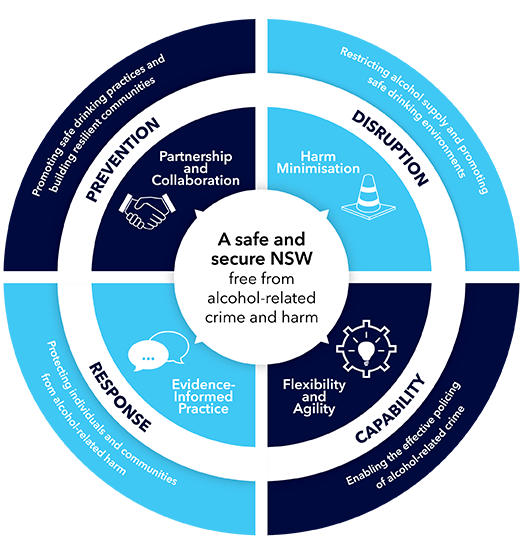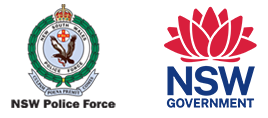The NSW Police Force is largely involved in reducing the inappropriate supply of alcohol. However to address alcohol misuse police also have an important role to play reducing the demand for alcohol as well as the harms experienced by individuals who drink excessively.
Alcohol Strategy
The NSW Police Force Alcohol Strategy 2019 - 2026 sets out how the NSW Police Force will work together with other agencies and the community to reduce alcohol-related harm and crime in NSW.
It builds on the already substantial efforts and responses of the NSW Police Force which have seen a significant reduction in alcohol-related crime in NSW.
Over the next seven years, four priority areas for reducing alcohol-related harm have been identified for police action:
- PREVENTION: promoting safe drinking practices and building resilient communities
- DISRUPTION: restricting alcohol supply and promoting safe drinking environments
- RESPONSE: protecting individuals and communities from alcohol-related harm
- CAPABILITY: enabling the effective policing of alcohol-related crime.

All police officers and commands across NSW are responsible for implementing the NSW Police Force Alcohol Strategy. The actions taken by any one command however, will be shaped by local circumstances and the command’s function within the NSW Police Force. This means the policing response to alcohol-related harm and crime will be flexible, agile and targeted as commands tailor their activities to meet their local needs and emerging issues.
Alcohol and Young People
Young people and particularly those under the age of 18 are vulnerable to the damaging effects of alcohol.
- In Australia alcohol is a key factor in the three leading causes of death among adolescents; unintentional injury, homicide and suicide.
- In 2012, young people aged 16-24 years of age were around twice as likely as the general population to drink at very high levels on a single occasion.
- For young people aged 18-24 years of age, the rate of emergency department presentations for acute alcohol problems was 54% higher in 2012 than in 2003.
- The rate of interpersonal violence hospitalisations in 15-24 year old males were around four times that of females in the same age group.
As well as the serious and obvious health consequences of excessive drinking, alcohol places the drinker and those around them at considerable risk of harm. Alcohol use, particularly excessive use can increase young people's risk of becoming a victim and / or an offender of alcohol related crime, often violent crime such as sexual assault, physical assault, robbery, driving accidents, violence and antisocial behaviour offences.
There are a number of laws in NSW designed to protect young people (under 18's) from being sold, given or from consuming alcohol. These laws apply to those that supply alcohol to under 18’s, and the under 18’s themselves.
NSW Police Force is committed to enforcing these laws and increasing community awareness of the legal, social and health harms associated with under-age drinking.
Liquor Laws and under 18s
In NSW, laws regulate the sale, consumption and provision of alcohol to people under the age of 18 years (minors). These laws are covered in the Liquor Act 2007 and the Summary Offences Act 1988.
Underage drinking laws at licensed and unlicensed premises
The Liquor Act 2007 governs the restrictions applying to under 18s in licensed and unlicensed premises.
Section 118 deals with the consumption of liquor by minors on a licensed premise. A minor must not obtain, consume or carry liquor away from a licensed premise. Fines range between $220 and $2200.
Section 117 deals with the supply of alcohol to minors.
A person (including a parent or guardian) must not sell or supply alcohol to a minor in any licensed premises in NSW.
Only a parent or guardian (or a person authorised by the parent or guardian) may supply alcohol to a minor at an unlicensed premises (including a family home), however the supply must be consistent with the responsible supervision of the minor. In relation to the responsible supervision of a minor the following matters are considered:
- the age of the minor
- whether the person supplying the alcohol is intoxicated
- whether the minor is consuming the liquor with food
- whether the minors consumption of liquor is being responsibly supervised by the person supplying the liquor
- the quantity of liquor and the period of time over which it is supplied
The supply of alcohol to a child who is intoxicated is not, in any circumstance, consistent with the responsible supervision of a minor.
Significant fines apply. A $1,100 on-the-spot penalty can be issued or the courts can impose fines of up to $11,000 and/or 12 months imprisonment.
Possession of liquor by minors
The Summary Offences Act 1988 Section 11 deals with the possession of liquor by minors in a public place.
A minor must not possess or consume any alcohol in a public place unless they are under the supervision of a responsible adult, or they have a reasonable excuse for possessing or consuming the alcohol. If a police officer suspects a minor is in possession of alcohol in a public place, they can confiscate the alcohol from the minor and the minor maybe fined.
Evidence of age
If you are under the age of 18 years and you use false ID in order to enter, remain in, or buy alcohol from a licensed venue you may be issued with an on-the-spot penalty of $220 and fined up to $2,200 by a court. You may also have 6 months added to your provisional driver’s licence.
If you are suspected of committing an offence, licensees, staff, security, police officers and inspectors can ask you to state your full name, home address and date of birth. If you fail or refuse to produce an acceptable proof of age document, you may be issued with a $220 on-the-spot penalty or fined up to $2200 by a court.
Information in relation to underage drinking fines
Alcohol and Road Safety
Drink driving
If you drink and drive over the legal drink-driving limit, you are breaking the law and could lose your licence, get a fine or go to prison.
In NSW there are three blood alcohol limits.
- Zero alcohol limit for all:
- Learner drivers or riders
- Provisional 1 drivers or riders
- Provisional 2 drivers or riders
- Visiting drivers or riders holding an overseas or interstate learner, provisional or equivalent licence
- Under 0.02 applies to:
- Drivers of vehicles of "gross vehicle mass" greater than 13.9 tonnes
- Drivers of vehicles carrying dangerous goods
- Drivers of public vehicles such as taxi or bus drivers
- Under 0.05 applies to:
- All other licences (including overseas and interstate licence holders) not subject to a 0.02 or zero limit
- Under 0.05 is the legal limit for most drivers
For further information in relation to blood alcohol limits, random breath testing, using other drugs, sobering up and getting home safely, visit the Centre for Road Safety.
Pedestrian
Many pedestrians who are injured or killed were affected by alcohol at the time of the accident. For information and advice about this important issue, go to:
Safe transport options
There are many safe transport options available, making it easier for people to socialise and get home safely. Your local Council may have information about what services are available in your area. You can also check out your local Liquor Accord as many Accords operate safe transport programs. It is a good idea to plan your transport options before you leave home.
Alcohol - Reducing the Risks
Australian Guidelines to Reduce Health Risks from Drinking Alcohol (2020)
The Australian Alcohol Guidelines (2020) Recommend:
- if you drink regularly, drink no more than two standard drinks each day
- on a single occasion, drink no more than four standard drinks
- young people under 18 years of age should not drink alcohol
- the safest option for a pregnant or breastfeeding mother is not to drink alcohol.
Australian Standard Drinks
A standard drink is 10 grams of pure alcohol. The type of alcohol makes no difference, 10 grams of alcohol is 10 grams of alcohol, whether it is in beer, wine or spirits. It does not matter whether it is mixed with soft drink, fruit juice, water or ice.
It is import ant to remember that alcohol is not always served as a standard drink. Pre-mixed spirits and free poured drinks often contain more than one standard drink.
- To reduce the risk of harm from alcohol-related disease or injury, healthy men and women should drink no more than 10 standard drinks a week and no more than 4 standard drinks on any one day. The less you drink, the lower your risk of harm from alcohol.
- To reduce the risk of injury and other harms to health, children and people under 18 years of age should not drink alcohol.
- To prevent harm from alcohol to their unborn child, women who are pregnant or planning a pregnancy should not drink alcohol.
For further information in relation to alcohol guidelines and the Australian standard drink, please visit the Australian Government National Health and Medical Research Council.
https://www.nhmrc.gov.au/health-advice/alcohol
Useful Resources
There have been a number of strategies and campaigns set up by various agencies with a view of reducing alcohol-related harms and maintaining a safer drinking culture in Australia. For further information, refer to the following links.
Agencies & Campaigns
Department of Health and Aged Care– provides information about related health issues and Australian government policy.
Alcohol and Drug Information Service (ADIS) NSW – operates 24 hours a day, 7 days a week to provide education, information, referral, crisis counselling and support. Call (02) 9361 8000 (Sydney metro) or 1800 422 599 (outside Sydney metro and interstate).
Your Room – provides drug and alcohol information and advice, campaigns and resources.
Aboriginal Health and Medical Research Council – provides links to Aboriginal community controlled health services across NSW.
Drug and Alcohol Multicultural Education Centre (DAMEC) – provides services for people from culturally and linguistically diverse communities.
Drug Info - run by the Australian Drug Foundation (ADF), the core purposes of the ADF are to prevent drug problems and reduce drug-related harms.
DrinkWise - not-for-profit organisation aiming to develop and maintain a safer drinking culture in Australia.
Drinking Nightmare - part of the National Binge Drinking Campaign, the main objective is to contribute to a reduction in harm associated with drinking to intoxication amongst young Australians.
Youth Law Australia - provides legal information to children and young people in Australia.
Lockout laws and last drinks to remain in Sydney - The NSW Government will maintain Sydney's lockout and last drinks laws.
My Nite – provides information on safe parties and registering your party with the NSW Police Force online.
Parentline - supports and nurtures positive, caring relationships between parents, children, teenagers and the significant other people who are important to the well-being of families.
Kids Helpline – provides a free, 24 hour counselling service for young people aged 5 to 25 years. Counselling is offered via the website www.kidshelpline.com.au or call 1800 55 1800.
ReachOut – provides practical tools and support to help young people get through a range of issues
Your Choice – provides practical tools and information in relation to the consequences of binge drinking, especially for teenagers.
Drink Spiking – Drink spiking occurs when a person adds alcohol or another drug to a drink without the knowledge of the person who will be drinking it.
Young People - The NSW Police Force has a strong commitment to building trust with young people while reducing crime, violence and fear of crime in the community.
Positive Choices - Get the facts, Stay smart, Stay safe

